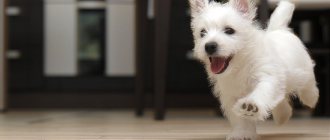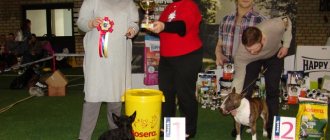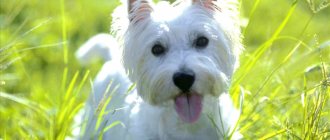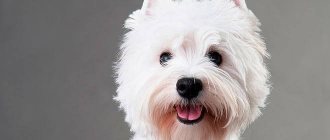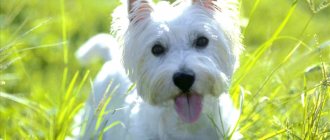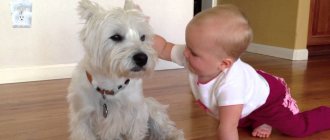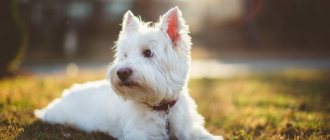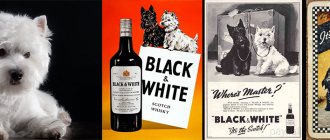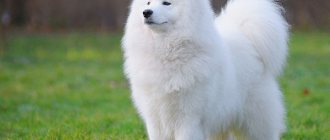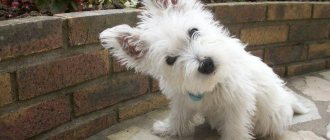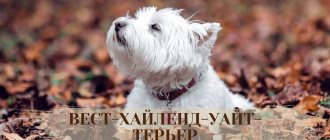The West Highland White Terrier is an endlessly cheerful, kind and sociable dog originally from Scotland. This breed is especially popular in Europe and the USA. An outstanding appearance, a sharp mind, combined with a courageous and decisive character distinguish these dogs. With their appearance, large head and beady eyes, they resemble a soft toy. An inquisitive and playful dog, like most terriers, he is quite stubborn, but he is much more flexible than other representatives of the group.
Brief history of the breed
The history of the West Highland White Terrier breed is a mystery to dog handlers. Presumably, the first dogs of this type appeared in the 12th century. They were bred in the Scottish mountains to hunt burrowing animals. Most likely, they have common roots with other terriers of English origin.
Edward Donald Malcolm made a great contribution to the development of the breed. It was under him that white terriers ceased to be considered a marriage. Red or brown individuals were often killed during hunting, confused with game, and the non-standard color helped solve this problem. At the beginning of the 20th century, the first club of West Highland lovers appeared in Scotland, and two years later the animals were recognized in England, which brought them world fame.
On a note. Another name for the breed is White Highland Terrier. Amateurs often call her simply “Vestik”.
Interesting facts about the breed
Despite the fact that the history of West Terriers goes back more than one century, every year they become even more popular. Several interesting facts will help you learn more about this breed:
- West Highland White Terriers, like most terriers, are very fond of stealing gloves, socks, stuffed animals, slippers and other small things.
- The streamlined body shape allows West Terriers to squeeze into the narrowest holes in which they often get stuck. Representatives of the breed call for help with their ringing bark, remaining in the hole until the owners come to the rescue.
- The name of the breed “west highland white terrier” is literally translated from English as “western highland white terrier”.
- Among all the currently existing varieties of terriers, Westies are considered the most affectionate and jealous of their owner.
IV. TRIMMING
All wire-haired terriers, whose coat consists of a short, dense and delicate undercoat and elongated, coarse guard hairs, are usually trimmed. In such dogs, natural shedding is not pronounced. However, dying hair must be removed regularly, as it no longer protects the dog from getting wet, is not cleaned and distorts the silhouette.
The guard hair of all wire-haired terriers is club-shaped with a thinning base. In place of the plucked hair, a new, elastic and hard one grows. When the hair is cut, it grows at the expense of the lower thinned part, and the wool becomes soft. Therefore, you cannot cut your hair with a clipper or scissors!
Only certain areas can be subjected to such treatment and only after stripping. So the beauty of the coat of wire-haired terriers depends entirely on the timeliness of stripping.
It is advisable to pluck the puppy’s fur for the first time at 3 months. Further, as the wool matures. Exhibition news is subject to this procedure at least once a month. Pets are trimmed less often - once every 2-3 months.
You should not turn to random craftsmen. Get recommendations from your breeder, he will probably recommend a groomer for you. Contact a specialist - and your dog will always look well-groomed and arouse the admiration of others.
Breed description, standards and appearance
A typical representative of the West Highland White Terrier breed is a small but strongly built dog with a deep chest and muscular limbs. The modern West Highland White Terrier breed standard was adopted in 2011. The document indicates the ideal sizes of pets:
Official description of the breed:
The West Highland White Terrier runs freely and easily, swinging its front legs well. In this case, the hind legs play the role of a spring and move very close to each other. Stiff and stilted movements are extremely undesirable.
Varieties
There are no intrabreed varieties of West Highland White Terriers. There are three classes depending on the severity of breed characteristics and pedigree:
The choice depends on the goals being pursued. Pet-class dogs do an excellent job as pets, and those who dream of conquering pedestals should prefer show-class dogs.
Color
The West Highland White Terrier breed has a double coat with hard and straight guard hairs about 5 cm long. The soft undercoat lies tightly to the body. Standing fur is not welcome.
The only allowed coat color is white. During the formation of the breed, there were cream, red and black West Highland Terriers; now puppies of non-standard colors are considered defective.
On a note. A relative of the West Highland, the Black Fell Terrier breed, on the contrary, is black in 95% of cases.
Grooming the West Highland White Terrier
According to the FCI standard, the West Highland White Terrier is a small, powerfully built dog with a deep chest, straight back and strong, muscular limbs. It is a balanced combination of strength and mobility. The West Highland White Terrier has a playful and cheerful, but strong character, a developed sense of self-esteem, wariness of strangers, courage and independence. When caring for the coat, you should remember all these qualities and try to properly emphasize them.
The West Highland White Terrier's closest relatives are the Scotch Terrier and the Skye Terrier. At first glance, this seems implausible, since each of these breeds is significantly different from the others. However, in reality, the visible differences are largely due to the characteristic grooming habits of each of these breeds. For example, the West Highland White Terrier and the Scotch Terrier differ very slightly in the structure of the skull, but the general outline of the head of representatives of these breeds is very noticeably different. This difference is a result of the care, handling and styling of the coat. A characteristic feature that distinguishes the Westie from its close relatives is the expressively round shape of the head, which is created through certain techniques for processing the hair on the head and that is why it requires the greatest attention. It should be remembered that it is not enough to be a good master: a necessary condition is also the high quality of the coat on the dog’s head and face. In other words, proper grooming techniques will only have successful results if there is something to care for.
Contrary to the established rules, according to which the processing of terrier hair begins with the head, in the case of wet highland white terriers this should be the final stage: the size of the head must fully correspond to the size of the body. It goes without saying that such a match can only be achieved after the hair on the body has been processed.
Coat processing begins with trimming the upper and side parts of the neck, on the back and sides of the body, and then on the tail. All of these body parts, which are quite large in area, are plucked using a trimming knife. However, before plucking begins, it is necessary to comb the hair between the ears and on the parietal part of the head forward: onto the forehead and cheekbones of the muzzle. The hair under the ears and on the cheekbones should be combed in the same way. Only after this can the area of the head located 1 cm below the occipital protuberance be treated. The dog's coat should be “mature”, i.e. grown enough. You should not take too much wool into one pinch: it is enough to collect small bunches of approximately the same size. Under no circumstances should the hair on the neck, back, tail and adjacent parts of the body be cut with scissors - neither ordinary nor special, since as a result of cutting with scissors it seems to soften, which is extremely undesirable. In order to obtain the results required by the standard by plucking, you should use a high-quality trimming knife.
The sides of the neck are plucked approximately to an imaginary line connecting the shoulder joint to the base of the auricle. On the sides of the body, the hair should be plucked to an imaginary line running from the elbows to the groins, and then moving towards the ischial tuberosities. Some instructions recommend continuing this line horizontally to the end. This is exactly what the simplest scheme for processing hair looks like, but from the point of view of the dog’s general appearance, such a scheme has many disadvantages. Due to the almost horizontal position of the border separating the plucked surfaces of the sides from those side parts where long hair remains, an optical lengthening of the dog’s body occurs. However, both with a curved and horizontal border, the transition between two adjacent planes must be processed so that the short hair smoothly and imperceptibly passes into the long one.
The coat should be plucked very short. A dog that is going to be exhibited at an exhibition should be plucked long before the show so that the hair has time to grow. The coat should be up to 5 cm long, stiff and close to the body. Loose fur is highly undesirable and should not be soft, wavy or curly. Wool of the specified quality should be not only on the upper or side surfaces of the neck and on the back, but also on the hips and croup. Plucking these parts requires extreme attention, since many individuals here have poor quality coats. Often the fur is too soft and sticks out to the sides. Dogs with deficiencies in their coat structure should be plucked more frequently. The tail is also processed by plucking. It is necessary that this part of the body be covered with moderately long, hard, close-lying hair. Finally, the tail should be processed with simple or thinning (with one serrated side) scissors until it acquires a cone shape. In addition, you should always remember the requirements of the standard, which indicate that the tail must have a length of 12.7 to 15.4 cm (5-6 fingers), be straight and carried vertically upward. In no case should it be covered with tousled hair or hair so long that it looks like a “flag” at the bottom. If the tail of a particular individual deviates from the standard, during the cutting process you can try to correct its silhouette to some extent. If, for example, the tail is slightly longer than required by the standard, longer hair should be left at its base and in the lower part, thus forming a cone with a wider base.
The treatment of the hair at the base of the tail has a significant influence on the formation of the rear of the West Highland White Terrier's back line. According to the breed standard, the spine must be straight, the top line of the body must be straight, and in addition it must be short in the rear. The standard specifically states that the distance from the last ribs to the pelvic limbs should be small; accordingly, Westies should have a short body, and therefore a short top line. It is precisely due to the amount of hair at the base of the tail in its front part that it is possible not only to successfully change the visual impression regarding the length of the top line of the body, but also regarding its straightness. A current problem for many of this breed is a low tail set. This is associated with a greater or lesser deviation of the sacrum bone, which in turn entails a violation of the straight top line required by the standard. By appropriately processing the coat from the withers to the base of the tail, leaving different thicknesses of layers of high-quality covering wool in the appropriate places, it is possible to generally form a straight line of the body. In practice, unfortunately, it is when processing wool on the hip area and at the base of the tail that the greatest number of mistakes are made. The hair on the front of the chest, on the throat, and on the back of the neck should be cut short with special dog grooming scissors. The hair should be cut in the direction against the growth of the fur, from the upper part of the chest bone to the lower jaw. On the sides, on the sides of the neck, the hair should be processed so that the transition between the longer, coarser hair on the back of the head and the shorter hair on the neck is completely invisible. This transition can be made using a trimming knife, however, it is more successfully done with thinning scissors. The hair on the upper part of the neck should in no case overlap with the shorter hair on its lower part, much less stick out.
Once the coat on the neck is finished, a transition should be made between the short-cropped coat on the front of the chest and the longer, coarser coat on the shoulders. The shoulders should under no circumstances bulge, and therefore the hair on them should be cut short, using special scissors for grooming dogs. The transition from short hair on the shoulders to hair on the sides should be made using a trimming knife or thinning scissors, ensuring that it is smooth and unnoticeable. The hair on the elbows should be properly treated. The elbows should not stick out and therefore you should try to ensure that there is no hair sticking out on them. Excess hair is removed by plucking or trimmed with thinning scissors. Experienced craftsmen can use a regular knife for this, taking great care when working with it. With this method of treating elbows, the hair must be removed in small quantities, in separate strands. This method of treating hair on the elbows cannot be used on individuals with a restless character. The quality of wool processing on the shoulders and elbows should be assessed not only when viewed from the side, but also, mainly, when viewed from the front. Protruding elbows or hair sticking out on the elbows, disturbing the noble line of the neck, passing through the shoulders to the front line of the chest limbs, can only be seen when viewed from the front.
The hair near the anus is cut short with special scissors for grooming dogs. The plane to be cut should have the shape of a triangle. The upper corner of the triangle should be at the anus, and the lower corners should be formed using two curls of hair on the back of the thighs. At the same time, the transition from this plane to the fur on adjacent parts of the body should be processed. This transition to a longer coat of wiry hair on the back and back of the thighs should be accomplished using a trimming knife or thinning shears. At the same time, the longer coat should not overlap the shorter one or rise noticeably above it or stick out. Experienced craftsmen can use an ordinary knife when making the transition between these parts. They can make the transition very smooth and smooth, but great care must be taken so that if the dog moves unexpectedly, it does not injure it.
The fur on the legs and lower body should be left long. At the same time, of course, it requires constant care. On the front part of the chest, under the breast bone, the hair should be processed so that when viewed from the side it does not stick out forward, since hair sticking out forward optically increases the length of the dog’s body. In addition, the coat should be shortened so that it does not hang down to the ground. However, it should not be made too short. On the chest limbs, the hair should not be shortened noticeably at all. Here you only need to cut individual protruding strands, preferably with simple scissors. After processing the wool, the chest limbs should look like short columns, quite strong and solid.
The lower line of the body is shaped in such a way as to reveal a moderate rise of the chest towards the groins. The fur on the belly and chest should first be combed forward, and then the ends of the strands should be cut to the desired length. According to the breed standard, the chest should be deep, which means the hair on it should be long to emphasize the depth of the chest. Between the thoracic limbs, where the depth of the chest is greatest, the fur can reach almost to the ground. Then the lower line of the body should gradually rise. At the level of the groins, the hair should be 1-3 cm shorter than in the place where the chest has the greatest depth. At the level of the groins, the lower line of the body passes into the fur of the knee joints of the pelvic limbs. The lower line of the body should be treated with ordinary sharp scissors. On the front parts of the pelvic limbs, the hair should not be too short. However, to give the limbs the desired shape, it is necessary to cut off individual protruding strands. First of all, the hair is combed upward from the paws to the knees; then they lightly smooth it down and cut it in such a way that the front line of the coat of the pelvic limbs rises from the paws along an oblique upward to the groins. Likewise, on the hindquarters of the pelvic legs, the long, prominent strands of hair are clipped to such an extent that when viewed from the side, the back line of the legs appears as a smooth, elegant continuation of the line of the tail and hips. When forming the line of the pelvic limbs, care should be taken to ensure that the dog holds the show stand with the pelvic limbs positioned as far back as possible. Between the limbs there should be no curtain of long hair reaching almost to the ground. Therefore, the hair on their inner sides should be shortened so much that when viewed from behind, a gradual, uniform rise is visible with a clear and clean line of the coat. To straighten all the fur lines of the pelvic limbs, it is best to use ordinary sharp scissors.
Particular attention should be paid to processing the hair on the outer surfaces of the thighs. First of all, you should shorten the hair on the lateral surface of the thigh, limited at the top by a line between the plucked hair on the sides and the longer one on the lower part of the body, drawn from the groin upward towards the ischial tuberosity, and from below - a line drawn from the groin down to the knee joint and from knee joint to hock. It is best to pluck it with a trimming knife, but you can cut it with thinning scissors. In order for the coat to be thick, tough, but not too long, it is necessary to pluck it short enough. A dog that is going to be exhibited should be plucked and clipped in advance, depending on the rate of hair growth, since the length of the hair on the outer part of the thighs is very important: in no case should it be processed on this plane in such a way that when viewed from behind it would be visible so-called "breeches". They can be formed due to excess hair protruding beyond the lateral line of the pelvic limbs. All this hair should be removed to such an extent that the outer (lateral) line of the pelvic legs is a smooth curve running from the base of the belly to the paws. However, the hair on the outer thighs should be slightly longer than on the sides of the body. Otherwise, the planes of the sides, connecting with the planes of the hips, can create the visual impression that the dog has too long a body. The hair on the ends of the paws is cut in a circle so that it does not extend anywhere beyond the tips of the fingers. When cutting the hair on the ends of the paws, you should remember the requirements of the breed standard, according to which the paws of the pelvic limbs must be smaller than the paws of the chest limbs. All excess, protruding hair is smoothed out with ordinary sharp scissors.
After finishing processing the hair on all surfaces of the body, you can begin processing the hair on the head. Using special scissors for grooming dogs, you should cut the hair on the outer and inner surfaces of the ears short to the level that the ends of the strands of hair on the head near the ears reach. In this case, it is necessary to cut with special attention and caution, since the upper parts of the ears should not be cut too deeply. The wool along the edges of the shells is also cut only to the level that the ends of the strands of wool on the head reach.
Trimming the hair on the head to give it a “rounded” shape requires a special technique. The wool is cut in small bunches, and such a bunch should be held between the index and middle fingers of one hand, and then cut off the ends of the strands with straight sharp scissors. They are cut in an arc, and not in a straight line, until they reach the length of the wool near the ears. , and when cutting a forelock - half the length of the bridge of the nose. Before cutting begins, all hair on the head should be combed forward and then begin cutting using the technique described earlier, cutting from the right or left ear towards the beard. The clipped coat should be combed strand by strand towards the front of the muzzle. The process of processing hair around the ears requires special attention. Between them, the hair is cut so that when viewed from the front, an arc is created connecting both ears. The inner borders of the ears should protrude from this fur without any transitions. However, from the outside, the hair on the ears must be cut, forming a smooth transition from the ears to the side lines of the head silhouette. The tips of the ears should be pointed as required by the breed standard, and the ears should not be too close to each other, but not too far apart.
The requirements of the breed standard indicate that the hair on the ears should be short and velvety, and at the same time it is recommended not to cut it; the latter can be achieved only in one way: the hair on the tips of the ears should be plucked regularly from an early age of the dog (just as it should be done , for example, in the Norwich Terrier). Under no circumstances should you cut it with scissors even once, otherwise it will never be plucked out. Attempting to pluck the hair after just one grooming will simply be painful for the dog, but ultimately it will not be possible to achieve the quality of wool required by the standard. In modern practice, the hair on the upper parts of the ear is trimmed with special dog grooming scissors, as described previously. If the dog is going to be exhibited at an exhibition, the hair on the upper parts of the ears should be cut again a few days before the exhibition, but at the same time to such a level that it has time to grow to the required length for the exhibition. The tops of the ears should not be bare or covered with too short or too long hair. The wool here should be exactly “velvety”. The hair on the frontal part of the skull is also gradually trimmed using the technique described above through the fingers to such a length that when viewed from the side, in profile, the head acquires a round shape. From the nose down and then up to the back of the ears, the line of the clipped coat should form smooth arcs. The hair on the parietal and frontal parts creates a forelock, which, when viewed from the side after cutting, should have smooth rounded borders. You should start cutting the hair that creates the forelock between the eyes. A strip of wool about 1 cm wide should be combed forward, towards the nose, and then cut to approximately half the length of the back of the nose. In this case, care must be taken that individual tufts of wool are cut to the same length.
The bridge of the nose should be cleared of excess hair. The hair growing on it should be combed downwards, and then all strands sticking up or to the sides should be carefully removed, best with simple sharp scissors, and in calm, obedient individuals this can be done with a sharp knife. As a result of this procedure, under no circumstances should a parting be formed. Not a single strand should fall on the nose, much less go beyond it. When viewed from the side, the curved lines that create the silhouette of the head should be as close as possible to the shape of a circle. The processing of hair on the head must be done with great care to avoid large clippings. It is much better to cut the head in several steps than to cut the hair too deeply in one step. If the round silhouette of the head is disturbed due to excess hair, it should be removed during the final haircut and the silhouette should be brought to meet the requirements of the standard. When looking at the head from the back, the tips of the ears should protrude from the hair, cut in a beautiful, smooth arc. After processing the hair on the head, it is necessary to comb it again in order to check whether the silhouette is smooth throughout and whether all parts of the head are cut in proportion to one another and in accordance with the requirements of the breed standard. In order for the hair on the head to acquire and maintain a standing position, you must first of all monitor the length of the coat. A coat that is too long does not hold up well in a standing position. Then it is necessary that the wool be of different quality. Coat quality can be improved by giving your dog biotin supplements in the diet over time. Quite often, when caring for the hair of the head, owners use various hairsprays. However, in some cases at shows this is punished as illegal interference to change the general appearance of the dog. Therefore, it is much better to use special fixing substances designed for dog fur and that do not have the qualities characteristic of varnish or special powder, which at the same time whitens the fur.
All of the above proves that caring for the head coat of a West Highland White Terrier is a set of procedures that is by no means easy to perform. Those who want to learn how to correctly perform the necessary procedures and gain the necessary experience should prepare for the fact that the first attempts to independently process the hair on a Westie’s head will not be completely successful. However, it should be remembered that with each subsequent attempt the results will improve. For those who don't want to learn grooming techniques, it's best to take your dog to a professional. If you plan to exhibit your dog at an exhibition, you should contact a professional trimmer and groomer. Since, as a rule, the competition at the exhibition is very high, any small flaw in the processing of the coat, distorting the silhouette of the dog, and also its general appearance, can become the reason that the highest-breeding and high-quality individual will not be awarded a high score. On the other hand, in dogs with some minor defects, due to the correct, proper treatment of the coat, these defects can somehow be smoothed out, improving the overall appearance of the dog.
Rules for transporting dogs across the border
Dog dental care
A puppy for yourself, for your pillow...
Related Posts
Character and behavior
The West Terrier is a cheerful, funny and very funny dog. She literally radiates positivity and quickly infects those around her with it. The little prankster is always ready for games, and his cute pranks do not let his owners get bored.
The pet surprisingly quickly adopts the manners and habits of its owners. At the same time, the character of the West Highland White Terrier breed is quite proud - pets do not lose their self-esteem in any situation. Because of their reckless courage, they are ready to chase both a cat and a large animal, which causes a lot of problems on walks.
Representatives of the breed do not really like small children - they are not recommended for families where a child has recently been born. However, they coexist peacefully with other relatives of comparable sizes and can even establish contact with a cat.
Attention! West Highlands are bred to be burrow hunters, so keeping small rodents in the house at the same time is not recommended.
How to choose the right puppy?
It is better to buy West Highland White Terrier puppies from well-known kennels that value their reputation. The breed is not very common in Russia, so animals are practically not sold by hand.
The reliability of the nursery is evidenced by positive reviews and the breeder’s willingness to help the new owner throughout the entire period of the baby’s growing up. A person who sincerely loves animals worries about the fate of each ward, so he will never give a puppy to the first person he meets.
On a note. Responsible breeders test animals for hereditary diseases. It is advisable to review the results before purchasing.
To choose the right West Highland White Terrier puppy, it is recommended to examine several litters - babies always differ in both appearance and character. Gender practically doesn't matter - both boys and girls will be best friends. However, some owners note that the former are easier to train.
In healthy white terriers:
- shiny coat without unpleasant odor;
- wet and cool nose;
- clean eyes and ears;
- easy and free movements.
Puppies should not have obvious defects, congenital deformities, or inflammation of the skin.
When choosing, it is important to pay attention not only to the exterior, but also to the temperament. You should look for an active, courageous, friendly and curious baby with an interested look. Overly active, cowardly and lethargic white terriers are best left aside. Along with the dog, the breeder is obliged to hand over the birth certificate and a veterinary passport with notes on the vaccinations given.
On a note. Famous nurseries in Moscow are “Magical Land” (www.westhighland.ru), “Asteri Maranti” (www.asterimaranti.ru), “Bright Nose” (www.west-terrier.ru).
Types of trimming
There are several types of pinches. Plaking is a pinch with the thumb and forefinger. Stripping is a pinch that uses a stripping knife.
Plaktom - the fur is plucked with sharp, quick movements. The strands are plucked at the ends, very carefully, so that the terrier feels more comfortable.
To prevent the wool from slipping out, it is rubbed with chalk, and rubber finger guards are put on the specialist’s fingers.
On the back of the neck and on the body, the hard coat should lie closely. It is shortest in the waist area, and longest at the withers. Approximate length up to five centimeters.
The coarse fur on the shoulder joint should be shorter than on the body. Do not fall apart into strands and fit tightly.
On average, the length can be from one to three centimeters.
The fur is plucked or cut on the front of the neck, on the tips of the terrier's ears, on the back of the tail, and in the crotch. One centimeter long, two millimeters at the ends of the ears.
On the paws, tail and head, the hair is plucked at the ends, giving the desired shape.
The longest part of the fur is the “skirt”, trimmed only from below.
Achieving a round head shape for a West takes approximately two years. “Chrysanthemum” is obtained by frequent pinching.
Using thinning scissors, the shape of the ears is triangular. The bangs and beard are trimmed.
You can emphasize the lines of the muzzle by short plucking the hair on the front of the neck. Due to the special sensitivity, it is better to cut it with a clipper or scissors.
Paws also require care. The fur is trimmed between the pads. The tail is first plucked, then trimmed with scissors; it should look like a carrot, only upside down.
To maintain your pet's excellent appearance, you need the hand of a professional. But the owner himself can take care of the dog’s fur, having gained some knowledge and skills.
Caring for puppies
For the first 2 weeks of life, West Highland White Terrier puppies are under the full care of their mother. Around the 15th day, complementary foods are introduced - goat's or sheep's milk, and they are taught to lap on their own. A week later, they begin to give semolina porridge with milk or meat broth. Month-old babies can already eat finely chopped meat and vegetable purees.
Having taken a West Highland White Terrier puppy to a new home, he is kept in a spacious enclosure for a couple of days so that he adapts to an unfamiliar environment. Then the baby is allowed to walk around the apartment, having first removed small objects, wires and household chemicals from the floor. A bed is set up in a secluded place where the dog can rest and be alone with himself.
A two-month-old West Highland White Terrier is given food 5-6 times a day at regular intervals in one place, which cannot be changed throughout its life. With age, the frequency of feedings is reduced:
- in 3–4 months up to 4 times;
- at 4–6 months up to 3 times.
After six months, the pet can be fed twice a day. The serving size is set individually, based on the baby’s characteristics and level of physical activity.
III. WASHING THE DOG
Wash your dog as soon as it gets dirty, but not more than once every 2 weeks. Before washing, the dog should be brushed. Don't wash your dog with random shampoos, especially those made for humans. Wash with special shampoos. The dog is washed with shampoo 2 times, after which the shampoo is thoroughly washed off.
As a result of exposure to the external environment, the wool becomes dry and damaged. The natural aging process also has an impact. The ends of the hair become fragile and brittle, the hair loses elasticity and natural shine, becomes dull, thin and weak. The skin loses moisture very quickly, flaking and dandruff appear. To reduce the negative impact of the external environment, it is necessary to use conditioner, which is applied to the wool after it has been thoroughly washed with water and dried. There is no need to rinse off the conditioner.
A properly selected conditioner will give an excellent effect - moisturizing the skin and coat, protecting and restoring the hair structure, and restoring elasticity. You should know that dry shampoos exist, but they are not intended for frequent use.
If certain areas become dirty, you can use a quick cleansing shampoo. The shampoo is applied directly from the bottle to the desired part, foam is whipped up and wiped dry. There is no need to wash it off with water. But it is also not intended for frequent use.
Care and maintenance
Grooming a West Highland White Terrier is not particularly difficult, but its snow-white coat requires close attention. Regular grooming will keep it tidy and will also keep your pet healthy.
The dog will be able to feel comfortable in a small apartment if the owner takes him for long walks. However, for an active animal, a private house with a garden plot is more suitable. The West Highland White Terrier dog breed is not afraid of the cold and can spend a lot of time outdoors.
The right diet
The breed is not picky about food, however, due to the tendency to allergies, the food should be hypoallergenic. Most owners prefer to feed the West Highland White Terrier with finished products. This approach saves time and eliminates the need to select proportions manually.
Food for the West Highland White Terrier must be of high quality - super premium or holistic. Currently, many foods of these classes are produced for dogs prone to allergies.
If there is a desire to give natural food, the diet of a dog of this breed is formed as follows:
Twice a week, a White Terrier dog should receive sea fish and eggs. Periodically she is given chicken and beef cartilage. After feeding, wipe the muzzle to remove any remaining food.
Important. Any fatty, salty, fried, pickled, smoked, spicy food and tubular bones are prohibited.
It is strictly forbidden to feed the West Highland White Terrier the following foods:
- chicken meat;
- chocolate;
- various flour products (including pasta);
- smoked meats;
- pickles;
- fat meat;
- bones;
- beet;
- potato;
- carrot;
- onion;
- legumes;
- mushrooms;
- nuts.
It is important! Despite the fact that West Terriers love to chew carrots and beets, it is not advisable to give them these vegetables, as they can cause a change in coat color.
Walking and physical activity
West Highland White Terriers need a lot of exercise to stay in top shape. It is not enough to just walk with your pet at a calm pace - he must throw out the accumulated energy.
In the city, it is undesirable to let animals off a leash - white terriers love to dig in the ground and destroy flower beds with lightning speed. It’s good if you have the opportunity to go out into nature. here the baby will be able to run around to his heart's content, but you need to be careful: if he smells new smells, he may lose control of himself and run away.
The White English Terrier needs not only physical, but also mental exercise. Therefore, dynamic games must be combined with developmental activities.
Training and education
The West Highland White Terrier has a fairly sharp mind, but is prone to dominance, so education cannot be trusted to children and adolescents.
From the first days of living in a new home, the puppy is taught basic behavioral norms - he is not allowed to sleep on the bed, beg at the master's table, chew things, or bark for no reason. In adulthood, correcting unwanted habits takes much more time and effort.
During the training process, owners are faced with the stubbornness characteristic of many terriers. In this case, you should act firmly and persistently, under no circumstances allowing your pet to take over. However, you should not shout at a West Highland White Terrier dog, much less hit it. The reward method works best - the pet is sincerely praised for good behavior and treated with a treat.
By six months, the pet should know a basic set of commands - “sit”, “lie down”, “fu”, “wait”, “come to me”, “next to me”. Lessons are held regularly so that he does not forget the material he has covered. Also, the West Highland White Terrier breed can learn a variety of tricks - the main thing is that the owner has a desire to practice.
Hygiene
The West Highland Terrier has a snow-white coat that needs to be brushed every 2-3 days with a wire brush. During seasonal molting, this is done daily. It is best to bathe your pet once a month. Representatives of the breed are washed with hypoallergenic shampoos that do not irritate the skin and mucous membranes. Thanks to special cosmetics, the fur does not lose its natural shine.
The West Highland White Terrier's haircut can be hygienic or decorative. In the first case, long hair around the eyes, mouth, anus and genitals is removed. If the owner wants to give his pet an unusual look, he should contact a groomer - a dog hairdresser. However, cut fur becomes softer and no longer fits so tightly to the body. Therefore, it is better to trim show dogs.
Also, caring for the white terrier breed includes the following procedures:
After walks, pets must wash their paws. In winter, when sidewalks are sprinkled with chemicals, the pads can be lubricated with vegetable oil to prevent cracking.
Trimming
Like some other wire-haired breeds, West Highland White Terriers require trimming - plucking out dead hairs. The procedure is first carried out at 3-4 months, then repeated after 2.5 months. If you ignore this recommendation and immediately trim the puppy with a clipper, the fur will grow back very poorly. Restoring a luxurious fur coat will turn into torture for both the owner and the pet.
With the help of trimming, a multi-layered coat is formed, which emphasizes the natural silhouette of the West Highland White Terrier. Exhibition animals are treated every 4-5 weeks so that they always look well-groomed. Pets can visit the groomer less often - in spring and autumn.
On a note. The properly trimmed coat of the West Highland White Terrier does not mat, does not get wet, and provides excellent protection from adverse weather conditions. The hair looks alive - thick and shiny.
Vaccinations and susceptibility to disease
The first vaccination for West Highland White Terrier puppies is given at approximately 2 months, when the immunity transmitted through mother's milk weakens. They are protected from:
- canine distemper, or distemper;
- parvo- and coronavirus enteritis;
- rabies;
- hepatitis A;
- adenovirus infection;
- leptospirosis.
Children are given an anthelmintic 2 weeks in advance, since the toxins released by parasites can harm the baby during vaccination. After 21 days, a second injection is given to strengthen the immune system. Adult representatives of the breed are revaccinated annually and treated against fleas, ticks and worms every 3 months.
Hunting dogs are distinguished by good health. However, the breed is predisposed to certain pathologies. The West Highland Terrier is more likely than other animals to suffer from the following diseases:
- atopic dermatitis;
- pulmonary fibrosis;
- ichthyosis;
- hip dysplasia;
- dislocation of the kneecap;
- craniomandibular osteopathy;
- demodicosis;
- hyperuricosuria;
- Addison's disease;
- cancer.
The breed is also susceptible to pathologies of the eyes and cardiovascular system.
Lifespan
West Highlands live on average 13-15 years. Even in old age they remain playful and clear-minded. However, due to their susceptibility to a number of diseases, their health must be constantly monitored. At the slightest sign of discomfort, your pet should be taken to the veterinarian.
If you properly care for your dog, it can easily live 18 or even 20 years. Heredity plays an important role - even when purchasing, you should check with the breeder what diseases the puppy’s parents suffered from. Living in a family where calm and harmony always reign, the pet does not suffer from stress, and therefore gets sick less often.
I. GENERAL HYGIENE PROCEDURES
General hygiene procedures include caring for teeth, eyes, ears, paws and claws.
The dog's eyes should be clean and healthy. If discharge from the eyes appears, it is necessary to determine the cause and eliminate it.
Ear care (cleaning) is carried out once a week.
It is necessary to carefully monitor the condition of your teeth and gums, brush your teeth and, if possible, prevent the formation of tartar.
It is also common to inspect the dog's paw pads, interdigital spaces, and nails. Check to see if there are any foreign objects stuck in the pads that need to be removed; whether tangles have formed that need to be cut out. If the claws have grown a lot, they need to be shortened. When trimming claws, remember that each claw has a living part equipped with blood vessels and nerves. Therefore, it is necessary to cut the claw below the living part.
Pros and cons of the breed
The general characteristics of the West Highland White Terrier breed are more than positive; the disadvantages and advantages of these animals are outlined in more detail in the table below:
ProsCons
| Compact size and good looks | Possible stubbornness |
| Good learning ability | Tendency to various allergic reactions |
| Cheerful and friendly disposition | Specific coat care |
| Loyalty to the owner | Need for long walks |
The West Highland White Terrier breed is a wonderful companion for easy-going people who love hiking and traveling. However, in order to ensure a happy life for the dog, the owner must be willing to spend time on care, education and games.
